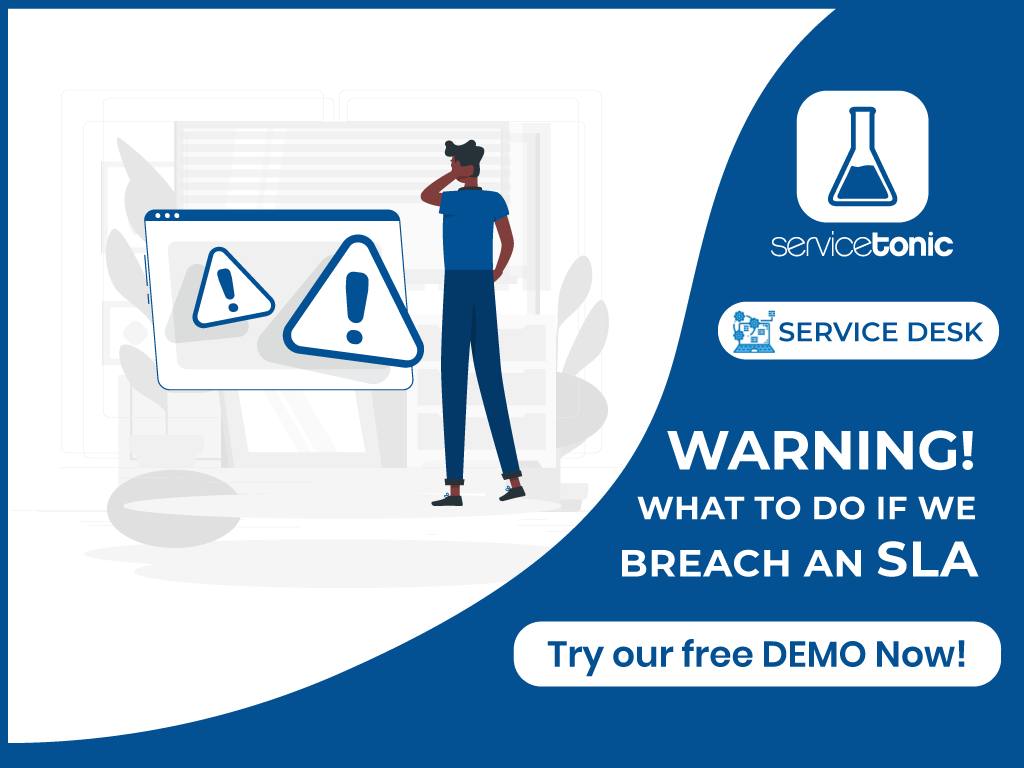Table of Contents
What to do if we breach an SLA
It is important to know what to do if an SLA is broken, so here are 5 essential steps to restore it.
But before we start, let’s remember what SLAs are: they are agreements with the customer that help us to meet their expectations.
In previous posts we have introduced the different types of SLAs (Service SLAs, Customer Based SLAs and Contact SLAs) and how to design them.
In this post we will discuss the steps to follow when one of these agreements is broken.
If an SLA is broken, just follow these steps:
It is not common to surpass an SLA if we manage them in an automated way in our service desk. Even so, it can happen.
At this point, it is important not to panic and to act methodically to restore service as soon as possible.
Communication and speed will be our allies in order to successfully restore the SLA, and turn a situation that was initially unsatisfactory into a positive one.
1. Alert the team
When we get a notification of SLA breach, it is important to alert the team involved in resolving the incident, to take part in SLA restoration.
Identify who is involved and who will be responsible for restoring it.
For example, if a customer expects to have a repair ready for a day but it is not possible because the service support team was unusually overworked, it is important to alert the entire team and identify who can perform the task urgently.
2. Find the fix
The person responsible for restoring the SLA must find the necessary fix.
Why did we breach the SLA?
Maybe we did not have the right means to complete the job.
Or perhaps we needed to redistribute the workload of our employees according to priorities.
First, we need to analyze, then we can act. If we reverse the order precipitated by the alarm state, the solution may not be effective in the short or long term.
3. Communicate with the customer
It is very important that we let the customer know that one of the conditions of the agreement will not be fulfilled as expected.
It is relevant that this is the 3rd step, just when we have found a solution and we are prepared to carry it out.
As clients ourselves, we prefer that our support team tell us that they cannot fulfill a service as agreed, and that they cannot comply with one of the conditions of the agreement, but that they are already working to get it done as soon as possible.
It is the difference between communicating an error or communicating that we have a solution to an error.
In addition, as an increasingly widespread practice, it is important to be transparent, if we are open we will cause empathy and clients will be able to understand our mistake. On the other hand, if we are opaque we will create mistrust.
Finally, beyond being honest, we must establish bidirectional communication with the client. This situation may cause criticism, discomfort or dissatisfaction. We must prepare ourselves to listen and respond to the customer’s feedback, with a tone of acceptance and looking to regain their confidence.
4. Act
A decisive step: find the necessary means and act to restore service as soon as possible.
5. Communicate the resolution
It is a fundamental step, closely linked to step 3 and the relationship with our client.
Informing that the service has been restored is more than a formality or a communication; it is an opportunity to turn an unwanted situation into something positive. Let us take care of the relationship with the client, and direct the communication to obtain their trust.
On a first level, thank them for their understanding, ask for an apology and/or offer a gift if necessary.
Nevertheless, add value to this communication conveying the values of your company. Communicate why it is important for you to offer the best customer service, how you work every day to get it, and most importantly, place the customer at the center of your mission.
After restoring the SLA
Before turning off the warning alarm, let us reflect.
- Was the SLA that we agreed with the client realistic?
- Do we have well-configured SLAs in our automation system?
- Did it break due to a circumstantial cause? Or could this situation occur again?
- How has it affected the team? What consequences did our customer have?
- Have we been able to re-establish the service properly?
- Have we been able to re-establish trust with the client? (Maybe we can send a survey so that the client can evaluate us).
In order to make this situation beneficial, we will evaluate what we have learned and what improvements we want to implement in order to always ensure compliance with our SLAs, and improve our service on an ongoing basis.




